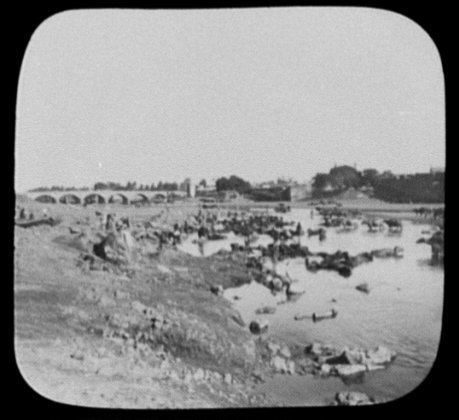Date 36 hours Total number of deaths 50,000 | ||
 | ||
The Great Musi Flood was a devastating flood that occurred on 28 September 1908 in the Hyderabad state capital on the banks of Musi river. The flood, locally known as Thughyani Sitambar, shattered the life of the people living in Hyderabad, killing 50,000 people. It washed away three bridges — the Afzal, Mussallam Jung and Chaderghat — the Puranapul became the only link between two parts of the city.
Contents
Flooding of Hyderabad
The Musi river was the cause of frequent flood devastation of Hyderabad city till early 20th century. It had begun to swell dangerously on September 27. The first flood warning came at 2 AM when the water flowed over Puranapul bridge. By 6 AM there was a cloudburst. The flood breached on Tuesday, 28 September 1908: The river rose 60 feet, flowing through the city. In 36 hours, 17 inches of rainfall was recorded, and the water level at Afzalgunj was about 11 feet (3.4 m) high and in other places even higher.
Damage
The worst hit area was Kolsawadi and Ghansi Bazar in Afzal Gunj. The flood razed over 80,000 houses, making a fourth of the population homeless. It completely destroyed the Nizam Hospital, burying the patients. It washed away the Afzal, Mussallam Jung and Chaderghat bridges, all built in the 1860s.
The Great Tamarind
A 200-year-old tamarind tree inside Osmania Hospital saved over 150 people who climbed it. Popular Urdu poet Amjad Hyderabadi, 22, saw his entire family, including his mother, wife and daughter washed away in the flood; he was the only survivor in his family. Most of his Ruba'i, Qayamat-e-Soghra reflects his depression at the loss. A couplet muses:
Aftermath
The historic deluge resulted in the development of the twin cities in 1908. This necessitated planned, phased development.
Committee recommendations
Syed Azam Hussaini submitted his report on October 1, 1909, with recommendations on preventing a recurrence of floods and improving civic amenities. The Seventh Nizam, Mir Osman Ali Khan, constituted a City Improve Trust in 1912. He built a flood control system on the river.
Sir Visvesvaraya’s services
In Hyderabad, following a catastrophic flood in 1908, Sir Visvesvaraya’s services were requested by the Nizam’s government in the construction of a flood protection system and a drainage system for the city. Sir Visvesvaraya proposed the construction of storage reservoirs of adequate capacity above the city, which proved effective in controlling future floods. In order to keep sewage from flowing into the river and prevent mosquito breeding, he built a sewage farm and laid pipes to carry the city’s sewage there.
A dam was built under noted engineer Nawab Ali Nawaz Jung Bahadur in 1920 across the river, ten miles (16 km) upstream from the city, called Osman Sagar. In 1927, another reservoir was built on Esi (tributary of Musi) and named Himayat Sagar. These lakes prevent the flooding of the River Musi and are major drinking water sources for Hyderabad city.
sri pothuluri veera brahmendra swamy's prediction
This devastation is predicted by Pothuluru Veerabrahmendra swamy in his kalagnanam.
